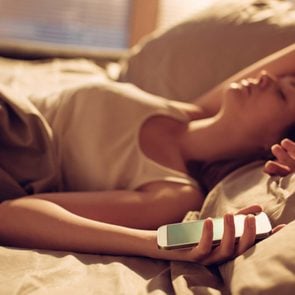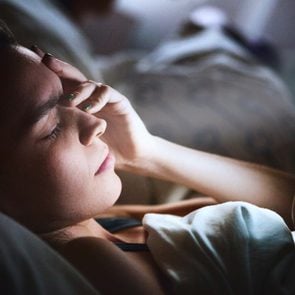Will Red Light Help You Sleep? What Experts Say About Sleeping With a Red Light
Updated: Mar. 11, 2022
You might know that blue light may strain your eyes and keep you awake. But what about red light? Here's what you need to know about red light and sleep, according to experts.
Little things can affect sleep quality
Sleep is a fickle thing. Anything from sleeping in the wrong position to an old mattress might be a sleeping mistake that keeps you from a good night’s rest.
One of the things standing in the way of good sleep could be too much light exposure.
But some people believe that using a specific type of night light—one that emits red light—could help you sleep better. (To be clear, we are not talking about a red-tinted lightbulb. These are special lights that emit light of a certain wavelength.)
Here’s what sleep doctors want you to know about how red light impacts sleep and whether you should or shouldn’t be sleeping with a red light on.
The relationship between light and sleep
Sleep, light, and melatonin are linked together. Melatonin is a sleep hormone that the brain releases in darkness. Your brain releases less melatonin when there is light exposure.
According to Alcibiades Rodriguez, MD, director of the Sleep Medicine Center at NYU Langone Health, melatonin is a marker of sleep. “It starts to rise two hours before our scheduled sleep time,” he says.
Light is the biggest contributor to training our circadian rhythm to our sleep and wake cycle, according to Raj Dasgupta, MD, a fellow of the American Academy of Sleep Medicine and assistant professor of clinical medicine at the Keck School of Medicine at the University of Southern California.
The circadian rhythm is the body’s internal clock that most notably affects sleep. “So in the morning, we get sunlight that will suppress the release of melatonin. And at nighttime, as the sun goes down, melatonin is released.”
Dr. Rodriguez says that light works as a zeitgeber, a naturally occurring ‘time clue’ that helps regulate our circadian rhythm. However, some types of light may help trigger sleep but others may disrupt it.
Sunlight includes different types of light, which have varying wavelengths measured in nanometers (nm). “The radiation spectrum that is visible to the eye of humans includes colored light with wavelengths ranging from 380 nm (purple) to 780 nm (red),” he says.
Blue light wavelengths are short, around 435-445 nanometers, and they suppress the release of melatonin. That’s why blue light glasses and shades exist to block blue light to help people sleep better at night, according to Dr. Dasgupta.
Red light has a longer wavelength than blue light. According to Dr. Rodriguez, red light is less disruptive to sleep than blue.
However, “ideally, it’s better to sleep with no lights,” he adds.
What the science says about red light and sleep
One of the theories behind red light is that it may increase the production or the release of melatonin, according to Dr. Dasgupta.
“And I wouldn’t say that this is the most exact science, but that’s the presumed mechanism of how red light works,” he says. “Out of all light wavelengths, red light might actually encourage the release of melatonin.”
Although there isn’t much research on this topic, there are some studies to consider.
One three-week 2019 study in Lighting Research and Technology of 19 people in an office space found that a combination of red and ambient white light in the afternoon improved their circadian rhythm.
Another small 2012 study found that 30 minutes of red light exposure for 14 days in female athletes seemed to improve sleep quality, melatonin levels, and endurance, according to the Journal of Athletic Training. In the study of 20 basketball players, half of the women had their entire body exposed to the light at night for 30 minutes while the others (the placebo group) weren’t exposed to any light at all.
In addition to melatonin, red light might have another potential sleep benefit. A small 2019 study in Nature and Science of Sleep found a connection between red-light exposure and reduced sleep inertia (morning grogginess). In a study of 30 people, researchers found that volunteers exposed to red light through closed eyelids (via a red-light mask or red-light goggles) had less sleep inertia than people exposed to dim light.
Red light is not a replacement for good sleep hygiene
Sleep sounds easy, but it’s hard to get. Dr. Dasgupta says the target group who might consider blue light shades and using red light are people with insomnia.
“I always say sleep is like a puzzle, and to get that perfect sleep, you need all those puzzle pieces, and people with insomnia are missing one of those pieces,” he says. The challenge is finding that missing piece.
For some, it’s sound, comfort, or temperature. That’s why things like noise machines and weighted blankets are so popular. For others, the missing piece might be light.
No matter what piece of the puzzle keeps you from good sleep, you need to make sure the basics of good sleep hygiene exist before looking at things like red light for sleep. For example, if you are eating an hour before bed and drinking alcohol, putting on a red light is not a helpful Band-Aid or quick fix to help you rest.
“You have to do the whole package deal,” Dr. Dasgupta says.
The keys to good sleep hygiene and a solid sleep foundation includes a set bedtime and wake time, using the bed only for sleeping, watching what and when you eat, and getting good exercise, according to Dr. Dasgupta. The goal is to go to bed at the same time, have no trouble transitioning into sleep, not wake up in the middle of the night, and feel energetic the following day.
(Here’s how to wake yourself up, naturally.)
Should you try red light for sleep?
The currently limited research available means it’s too early to conclude exactly how beneficial red light therapy might be for sleep.
Dr. Rodriguez says that no light is generally the best option for sleep, although red light is less disruptive. (Here’s one red light you can find on Amazon.)
Dr. Dasgupta stresses that your general sleep hygiene habits must be in order. Once that is in good shape, you can consider adding something like red light.
If you’re sensitive to light, adjusting it may be the missing thing that helps you rest. So Dr. Dasgupta says that if light has always been an issue, there is little downside to trying red light for better sleep.
“I think that if this is something where you want to try it at night time, and it does tip the scales into getting better sleep, then that something I’m going to promote,” he says.
Next, check out how to fall back asleep after waking up in the middle of the night.

















